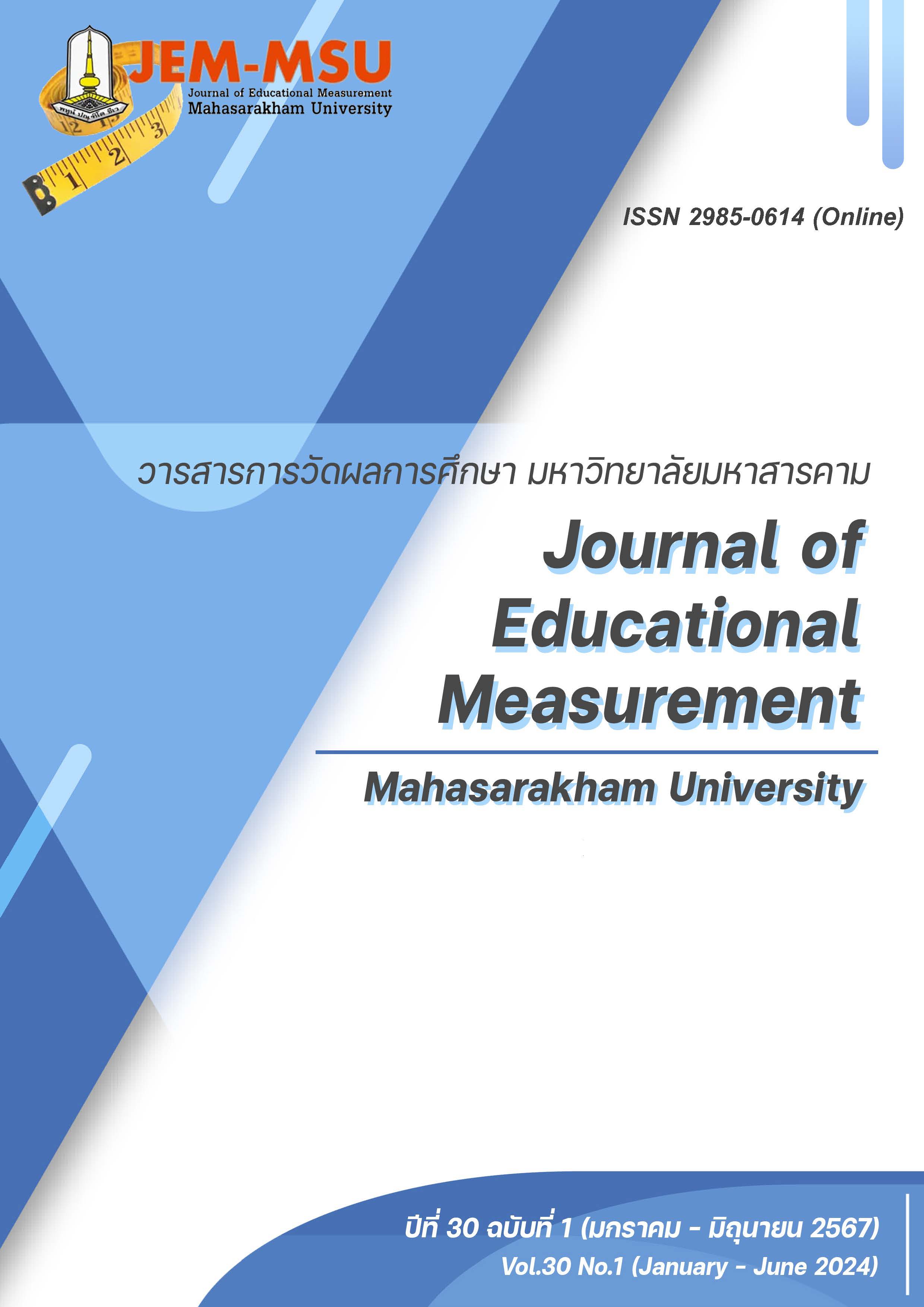The Construction of Mathematical Connection Ability Test for Grade Four Students
Main Article Content
Abstract
This research had the objectives to (1) construct a mathematical connection ability test for grade 4 students, (2) analyze the psychometric properties of the mathematical connection ability test for grade 4 students, and (3) analyze the mathematical connection ability of grade 4 students. The sample consisted of 100 grade 4 students at Ban Khlong Bua School (Iam Saengrot), Bang Khen District Office, under Bangkok Metropolitan Administration (BMA), using the technique of two-stage cluster sampling. The research instrument was a fifteen-item response test. The psychometric properties were analyzed from (1) content validity, (2) reliability, (3) difficulty, and (4) discrimination. The mathematical connection ability was analyzed using descriptive statistics of mean, frequency, and percentage.
The findings were as follows:
1. The construction of the mathematical connection ability test for grade 4 students yielded a fifteen-item response test with polytomous scoring. All items measured the concept of Connectivism by the National Council of Teachers of Mathematics of the United States of America (NCTM, 2000) in three standards: (1) remembering and making connections for mathematical concepts—five items, (2) understanding the connections of mathematical knowledge to see how they connect and using the knowledge to construct new knowledge in consistency with existing knowledge—five items, (3) remembering and applying mathematics in other contexts beside mathematics—five items.
2. The analysis of psychometric properties of the mathematical connection ability test of the students under study revealed that the content validity of all items passed the criteria. The reliability was 0.764, rather a high level, and passed the criterion. All the fifteen test items exhibited difficulty between 0.444 and 0.840. The discrimination was from -0.037 to 0.867.
3. The analysis of the mathematical connection ability of the 100 students under investigation found the following: The students had an average score of 32.25 from 52. When considering the assessment of mathematical connection ability, it was found that 73 students exhibited the mathematical connection ability passing the criterion with a score of 26 or higher than 50 percent of the maximum score (73.00 percent), meanwhile, 27 students exhibited the mathematical connection ability lower than the criterion with the score lower than 26 or lower than 50 percent of the maximum score (27.00 percent).
Article Details

This work is licensed under a Creative Commons Attribution-NonCommercial-NoDerivatives 4.0 International License.
The content and information contained in the published article in the Journal of Educational Measurement Mahasarakham University represent the opinions and responsibilities of the authors directly. The editorial board of the journal is not necessarily in agreement with or responsible for any of the content.
The articles, data, content, images, etc. that have been published in the Journal of Educational Measurement Mahasarakham University are copyrighted by the journal. If any individual or organization wishes to reproduce or perform any actions involving the entirety or any part of the content, they must obtain written permission from the Journal of Educational Measurement Mahasarakham University.
References
Avsar, A.S & Tavsancil, E. (2017). Examination of Polytomous Item’ Psychometric Properties According to Nonparametric Item Response Theory Models in Different Test Conditions. Educational sciences: theory & practice. https://www.researchgate.net/publication/312147279
Jenkins, D. (2020). Comparing Dichotomous and Polytomous Item Using Item Response Trees. Part of the industrial and Organizational Psychology Commons. https://corescholar.libraries.wright.edu/etd_all
Krejcie, R. V., & Morgan, D. W. (1970). Determining sample size for research activities. Educational and Psychological Measurement, 30(3), 607–610.
National Council of Teachers of Mathematics. (2000). Principles and Standards for school Mathematics. National Council of Teachers of Mathematics. www.nctm.org
Amornrattanasak, S. (2011). Research Methodology: Principles of Practice. Center for Academic Promotion Publishing. (in Thai)
Chuchuaysuwan, A. (2009). A Development of Mathematical Connection Ability Test for Mathayomsuksa V Students [Master’s thesis]. Srinakharinwirot University. (in Thai)
Chuetawat, C. (2020). A Study of Mathematical Connection Ability on Conic Section for Mathayomsuksa v Students via Stem Education [Master’s thesis]. Srinakharinwirot University. (in Thai)
Institute for the Promotion of Teaching Science and Technology. (2017). Manual for using the mathematics subject group curriculum (revised edition 2017) according to the Basic Education Core Curriculum 2008. https://www.scimath.org/ebook-mathematics/item/8378-2560-2551 (in Thai)
Jangsiripornpakorn, A. (2007). Educational measurement and evaluation. Chulalongkorn University. (in Thai)
Kanjanawasee, S. (2013). Classical Test Theory (4th ed.). Chulalongkorn University. (in Thai)
Koonkaew, A. (2022). Test New approaches to measurement and evaluation of education. Chulalongkorn University. (in Thai)
Kritkharuehart, S. (2021). Achievement Test Constructions. Ramkhamhaeng University. (in Thai)
Makanong, A. (2016). Mathematical skills and processes: Development for development (3th ed.). Chulalongkorn University. (in Thai)
Ministry of Education. (2017). Indicators and core learning content for the mathematics learning group (revised edition 2017) according to the Basic Education Core Curriculum 2008. Pollen Cooperative Publishing House of Thailand Co., Ltd. (in Thai)
Panthamit, D. (2017). Construction of Mathematical Connection Ability Test for Grade 6 Students [Master’s thesis]. Chiang Mai University. (in Thai)
Paramutthakorn, L. (2013). Development of Mathematical Knowledge and Connection Ability of Grade Five Students by Organizing Mathematica Learning Activities Based on Mui Tip Intelligence Theory [Master’s thesis]. Chulalongkorn University. http://cuir.car.chula.ac.th/handle/123456789/52618 (in Thai)
Ritjaroon, P. (2021) Learning measurement and evaluation techniques. Chulalongkorn University. (in Thai)


